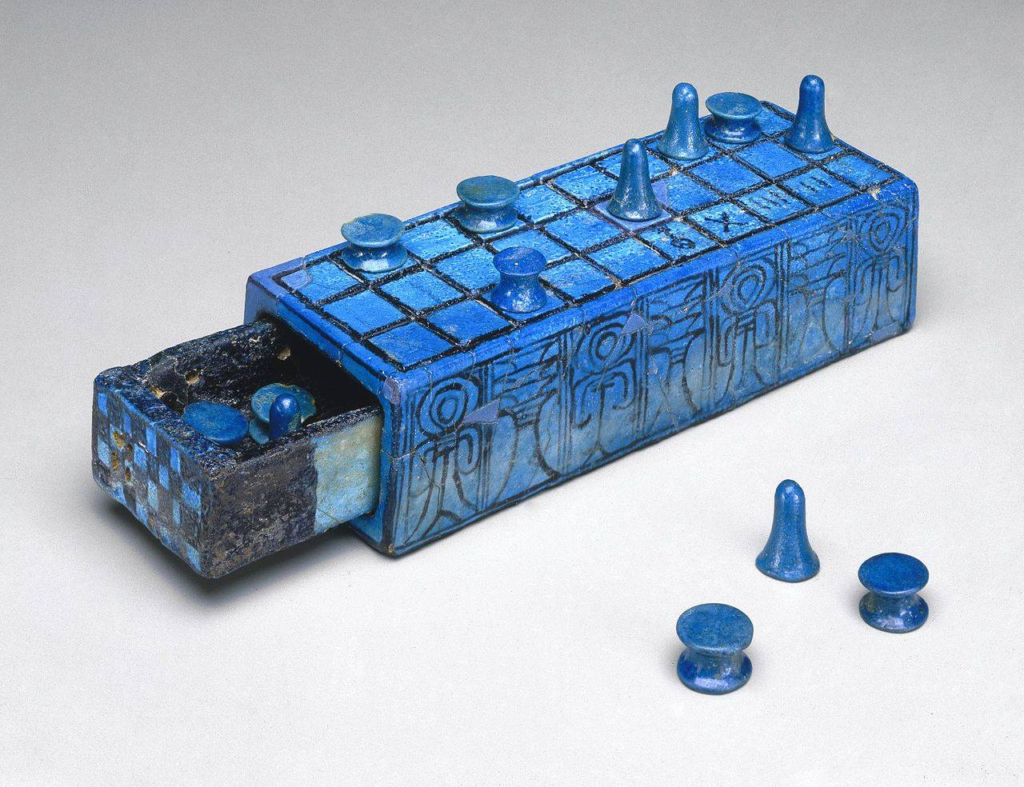THE OLDEST BOARD GAMES
Introduction: A Journey Through Time
Imagine a world without the endless variety of board games we have today. No Monopoly, no Scrabble, no Settlers of Catan. It’s hard to picture, isn’t it? But the truth is, our beloved pastime has a rich history that dates back millennia. Join us on a fascinating journey through time as we explore the oldest board games in the world, their captivating stories, and the lasting impact they’ve had on our favorite hobby.

The Royal Game of Ur: A Mesopotamian Classic
Picture this: you’re in ancient Mesopotamia, around 4,600 years ago. You sit down with a friend to play a game that’s all the rage – The Royal Game of Ur. This classic race game, similar to modern-day backgammon, has you rolling dice and moving pieces along a beautifully crafted board, hoping to be the first to reach the end.
The game’s popularity spread far and wide, with boards discovered in locations as diverse as Greece and Sri Lanka. Even King Tutankhamun, the famous Egyptian pharaoh, had a set buried with him in his tomb. The Royal Game of Ur was so beloved that it survived for thousands of years, with a thriving community of players existing well into the 1950s.
But what makes this game truly remarkable is that we have a near-contemporary set of instructions on how to play, thanks to an ancient tablet. This means that when you sit down to play Ur today, you’re experiencing the game just as the ancients did, connecting with a piece of history that’s over four millennia old.

Senet: The Favored Game of Egyptian Royalty
Now, let’s travel to ancient Egypt, around 5,000 years ago. Here, we find Queen Nefertari, wife of Ramesses II, enjoying a game of Senet. This scene, captured in a tomb painting, gives us a glimpse into the world of Egyptian royalty and their love for board games.
Senet, meaning “passing,” is a game that involves racing pawns to the end of the board while avoiding obstacles. Its origins are shrouded in mystery, with the oldest known depiction dating back an astonishing 5,000 years. Over time, Senet gained religious significance, becoming associated with the journey through the afterlife. This explains why Senet sets and paintings are often found in Egyptian tombs, and why the game is even mentioned in the sacred Book of the Dead.
Although the complete rulebook for Senet remains elusive, dedicated enthusiasts have reconstructed the game based on ancient texts. Today, you can purchase a reproduction set and experience the thrill of playing like an Egyptian queen or pharaoh, connecting with a tradition that has endured for five millennia.

Mancala: A Game as Old as Time
Our final stop takes us to Africa, where we discover the mesmerizing world of Mancala. This family of “pit and pebble” games has a history that is both ancient and vast, with evidence suggesting it may have originated anywhere from 3,600 to an incredible 8,000 years ago.
A stone board discovered in Jordan hints that Mancala could date back to the Neolithic era, or the Stone Age. However, the simplicity of the game means it can be played without a board, using only pits dug in the dirt and a handful of pebbles or seeds. This has led some scholars to question the age of archaeological finds, as these basic “boards” could have served other purposes.

Despite the debate surrounding its origins, there’s no denying the global impact of Mancala. The game and its variants have been enjoyed across Africa, the Middle East, India, Southeast Asia, and even the New World, known by hundreds of different names. In West Africa and the Caribbean, the version called Owari remains popular to this day, with both local and international tournaments celebrating the game’s enduring appeal.
The Secret to Mancala’s Longevity
So, what is it about Mancala that has allowed it to stand the test of time? The answer lies in its elegant simplicity and strategic depth. Players take turns moving pebbles or seeds along rows of holes, capturing their opponent’s pieces as they go. The basic rules can be learned in minutes, but mastering the game requires careful planning and foresight.
This perfect balance of accessibility and complexity has made Mancala a favorite across generations and cultures. In the West, a version called Kalah has been commercially available since the 1940s, while in southern India, Pallankuzhi remains a beloved pastime. No matter where you go, you’re likely to find a version of Mancala that reflects the local culture and traditions.
The Legacy of Ancient Board Games
As we’ve seen, the oldest board games in the world have left an indelible mark on our favorite pastime. The Royal Game of Ur, with its dice-based mechanics and race-style gameplay, laid the foundation for modern classics like backgammon and Parcheesi. Senet’s influence can be seen in the abstract strategy games that challenge us to outmaneuver our opponents, while Mancala’s enduring popularity is a testament to the power of simple yet deep gameplay.

But perhaps the greatest legacy of these ancient games is the way they connect us to our past. When we sit down to play Ur, Senet, or Mancala, we’re not just enjoying a game – we’re participating in a tradition that stretches back thousands of years. We’re sharing an experience with the kings and queens of old, with the farmers and the merchants, with the people who lived, loved, and played long before us.
In a world that moves at breakneck speed, where new games appear and disappear in the blink of an eye, these ancient classics remind us of the enduring power of play. They remind us that, no matter how much the world changes, there will always be a place for the simple joy of sitting down with friends and family, rolling the dice, and seeing where the game takes us.
Conclusion: A Timeless Tradition
The oldest board games in the world are more than just relics of the past – they are living, breathing testaments to the human spirit. They have survived the rise and fall of empires, the shifting sands of time, and the endless march of progress. They have brought joy and companionship to countless generations, and they continue to do so today.

So, the next time you sit down to play your favorite game, take a moment to reflect on the rich history that led to that moment. Remember the Mesopotamians who rolled the dice in Ur, the Egyptians who raced their pawns in Senet, and the Africans who sowed their seeds in Mancala. Remember that you are part of a tradition that stretches back to the dawn of civilization, a tradition that will endure long after we are gone.
In the end, that is the true magic of board games – their ability to connect us, to inspire us, and to remind us of the unbreakable bonds that unite us all. So, let us continue to play, to laugh, and to learn from these ancient wonders, and let us pass their wisdom and their joy on to the generations yet to come.



